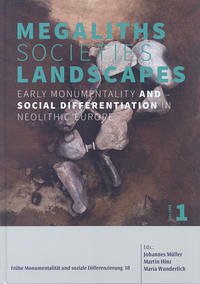The 5th and 4th millennium BCE saw the emergence of monumental architecture in Neolithic and Chalcolithic contexts throughout different parts of Europe. Current research is using a set of diverse methodologies and produces multilayered interpretations in order to create multi-faceted narratives on this phenomenon. The international conference »Megaliths, Societies, Landscapes. Early Monumentality and Social Differentiation in Neolithic Europe« aimed to bring together researchers from various regions and contexts, thus providing an up-to-date perspective on prehistoric monumental architecture. The conference was also an opportunity to present the results of the DFG-Priority Program 1400 »Early Monumentality and Social Differentiation. On the origin and development of Neolithic large-scale buildings and the emergence of early complex societies in Northern Central Europe« which focused the appearance of monumentality in the context of Neolithic Funnel Beaker communities. These proceedings present the result of this conference, covering topics such as monuments made of stone, wood and earth, as well as interpretative aspects such as the importance of monumentality for landscape construction and the social significance of monumentality. They comprise of wide-ranging case studies with a continental scope that illustrate the manifold implications and manifestations of monumentality. They also demonstrate the need of holistic approaches and the integration of diverse data sets for the understanding of a phenomenon of such complexity. For a wider understanding of varying forms of monumentality, ethnoarchaeological studies on megaliths from different continents were integrated as well. The conference proceedings show that the construction of monuments may have been driven by very different factors and was embedded in diverse contexts of social organisation, thus being a highly variable and transformative phenomenon.
Bitte wählen Sie Ihr Anliegen aus.
Rechnungen
Retourenschein anfordern
Bestellstatus
Storno

